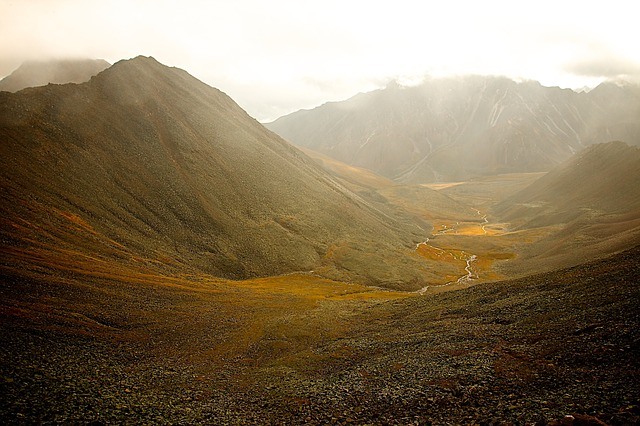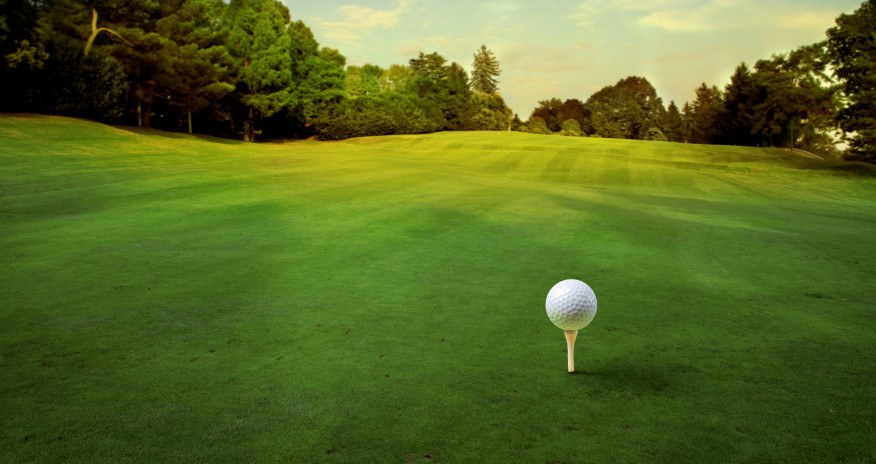Golf slope is perhaps the least-understood element in distance. Getting it right will make a real an immediate difference to both your scores and enjoyment on the course. Here is what it is and how it is really calculated.

Any golfer who has played an even slightly hilly course knows that changes in elevation can greatly affect their game. You could have the perfect iron set, it just won’t matter.These changes, if not properly taken into account, can be detrimental to your final score and nowadays there is no reason why this should still be the case. This is why understanding golf slope is key.
This is actually obvious to anyone from hacker to pro. We have all stood on an elevated tee and tried to guess just how many clubs difference it really makes. Of course, we usually get it completely wrong, hence the need for something that really tells us the difference that slope is going to make to the shot.
Golf equipment manufacturers know all about slope and have included features that are aimed at helping golfers compensate for these changes. If you are in the market for the best golf rangefinder with slope, it is important to understand just what it is and how the right golf rangefinder with slope can help take strokes off your game.
What Is Slope?
First, we need to specify just what kind of slope we are discussing. There is slope and slope! In golf, the term “slope” often refers to the proportional difficulty of a group of tees based off of high versus low handicapped golfers. “Slope” is then used as a relative score to communicate how difficult a set of holes are. we talk about the slope of a course (given as a number) and it is a relatively easy way of comparing courses and adjusting handicap from one course to another.
That’s not the kind of slope we’re discussing in this article.
The kind of slope we’re talking about here is the change in elevation between two points. Anytime you walk uphill or downhill you are walking up or down a slope. Think of triangle on its side and you’ll see a slope. On the course, we deal with this all the time because a shot that goes from one point to another that is at the same height is the exception rather than the rule.
Of course, most of the time, this difference is really enough to worry about, especially when most of us can’t hit every club exactly the same distance every shot anyway. This doesn’t mean you should just forget about it altogether though.
Why Is Slope Important?
Slope is very important for any golfer to consider. This is because, while you may calculate the distance between you and the flag in a straight line, you do not hit the ball in a straight line. The ball is hit at an arc and with a trajectory that effects how far it actually goes. Even if the exact physics of ballistics are beyond you (and they are certainly beyond me!) the principle is easy enough to grasp.
After your shot hits its peak, it begins to fall. And as it falls it continues to move forward. Depending on the slope of the land, this could affect the distance of your shot anywhere from 20 to 50 yards. That’s no small change!
A smart course architect actually uses this effect to trick the golfer. Well perhaps trick is too strong a word, but it is part of good golf course design to lure the golfer into thinking that he needs to hit it further or shorter and this is often done with subtle changes in elevation.

Therefore, knowing the slope at which you are hitting the ball is critical for determining club selection, velocity (how hard you hit the ball), and spin. In other words, pretty much all the criteria for hitting a good shot!
Balls will travel a shorter distance with positive (uphill) slope and a farther distance with negative (downhill) slope. Knowing just how much change in elevation occurs between you and the pin is extremely important and in all honesty, it is virtually impossible to do this by eye.
How Is Slope Calculated?
So, you might be thinking at this point, “Great, the green is ten yards higher than I am right now, that’s easy to account for!” But wait a second! Just because there is a ten-yard difference in elevation does not mean that the slope from you to the hole is ten yards!
It’s a bit more complicated than that. Remember all those times in Geometry class that you cried out, “When am I ever going to use this!?” Well, now would be one of those times. Bet you are glad you paid attention at school now, right? What? You didn’t? Never mind, here is the simple version.
To figure out just what club to use and how hard to hit the ball, you’d need to know the slope from you to the hole. And slope is calculated by dividing “Run” by “Rise.” This is actually something you can work out with a few (relatively) simple calculations, but the group behind you (and the ten groups behind them) might not appreciate waiting on you every time you get your pen, paper and pocket calculator out!
OK, we don’t have to go into all that here. Even if you did get your protractor out and calculate the exact slope between you and the hole, it probably wouldn’t be all that helpful. What we really need is a quick way of finding out how far to actually hit the ball compared to what we would expect.
This is where a rangefinder with slope comes in handy. By doing all that geometry you thought you’d never use, the rangefinder can give you an adjusted distance to shoot for. This adjusted distance is what we need in order to choose a club or know how hard to swing.
The rangefinder with scope will give you two readings: the actual distance to the hole and an adjusted slope distance. That is, a distance to shoot for given the slope that the rangefinder has calculated.

How Does a Rangefinder Calculate Slope?
Basically, the rangefinder shoots a laser out at a target. When the laser bounces off the target, the delay between its being sent out and returning gives the distances to the flagstick. This is a principle common to all golf laser rangefinder devices, although obviously some do it a lot better than others!
The other calculation that the rangefinder with scope can make is to calculate the angle of return. Unless you are exactly parallel to your target, the returning laser beams will be off a certain number of fractional degrees. The rangefinder is able to use this difference to calculate slope and give you an adjusted distance. This is what saves you doing maths in your head!
All you have to do is play this adjusted distance.
Will a Rangefinder with Slope Improve My Score?
Well, of course, there is no guarantee. But we can certainly say that failing to account for slope will certainly hurt your score. This is because you will likely be under or overhitting the ball. As you get better with adjusting and factoring in slope, you should see some improvement in your overall score. What is clear is that playing without knowing the slope is a whole lot harder.
This also depends on how much the course you play changes in elevation. A relatively flat course will not factor in much slope at all. On very hilly courses, failing to factor for slope could cost you dozens of strokes. I play ever year on a mountain course and from personal experience, my score will blow up if I try to eyeball it.
Does a GPS Calculate Slope?
While GPS might be able to give some indication of your relative elevation, it won’t be able to calculate slope for your specific situation. This doesn’t make it useless, but means that a course with a lot of height changes will reduce its effectiveness quite a bit.
This is because GPS works by using satellites to pinpoint your current location. Then, it calculates your current position against a set of pre-programmed data. Companies have programmed devices with GPS locations throughout various golf courses. The GPS device simply measures the distance between your current location and any of these predetermined points.
So, a GPS device will not be able to calculate for slope, but only estimate your distance to different predetermined locations on the course.
Can I Use Slope in Competitions?
The USGA has issued specific guidelines regarding the use of measuring devices. According to Appendix IV of Rule 14-3 no measuring device that calculates for slope may be used during tournament play.
This does not mean, however, that your rangefinder cannot be used at all. The USGA does allow for a Local Rule to permit a “stipulated round” in which measuring devices like rangefinders can be used. But even under these Local Rule situations, rangefinders that calculate for slope are not permitted.
So the long and short of it is, “no,” any rangefinder that calculates for slope is illegal for tournament play. However, depending on the level of competition, local rules permitting them are actually more and more common and it seems likely that they will be mainstream and accepted in all sorts of rounds over the next year or two.
But the good news is that these rangefinders are perfectly fine during practice, so you can easily use your rangefinder with slope to learn the lay of the land and get a feel for the changes in elevation.
Can I Turn Off Slope on My Rangefinder?
Rangefinder manufacturers are aware of this rule and have made models to compensate. Many of them have the ability to easily switch off the slope function. This might, however, still raise some eyebrows from other players or officials.
Some models have an added faceplate that makes it clear when the slope function is enabled and disabled. You should check your particular model to see just how easy it is to switch the slope calculation off and indicate to others that it has been disabled.
If you are looking for a rangefinder with or without slope, Nikon makes some of the best products out there for your money.
-
Which Club For One Club Golf
If you’re into golf but want to mix things up or keep things really simple, one club golf is a pretty neat way to test your skills. Playing a whole round with just a single club isn’t just about making the game more challenging. It’s also great for learning shot creativity and club control. If…






I just bought a range finder that doesn’t show you the slope. I just wanted to clarify how to read it properly. If the hole is 150 yards away and elevated, I can expect the range finder to show me the true distance (say 160 yards for example), correct? And if that’s the case, I would want to read the hole as the true distance of 160 yards, and most likely use a longer club (if we consider my ball flight and drop angle all the same)?
Hi Tyler,
If your rangefinder doesn’t show slope, it will simply show you the true distance to the flag, regardless of elevation. In your example, if the flag is 150 yards away, the reading on the rangefinder will be 150 yards, regardless of slope/elevation.
If you take the same reading using a rangefinder that has slope it will take into account changes in elevation and give you a reading telling you how far it is actually playing.
So in your example, you are 150 yards away and it is a long way up hill, a non-slope version will say 150 yards. A slop version might give you 165 yards because this is how far you effectively need to hit it taking into account to hill.
Hope that helps, Nick
That is incorrect. The rangefinder will give you a straight-line measurement to the pin (the hypotenuse). It will not give you a ballistic measurement (compensated distance for elevation gain).
Good afternoon
My rangefinder doesn’t give slope reading in yards but does have a angle display. So only gives me the true reading not calculated with the slope ie. I’m on a slightly elevated tee with 150 yards to the flag the small angle display my ready 3% this isn’t giving me a yardage reading for the slope so is that ok ??
Steven Moss
Hi Steven,
Apologies for the slow reply. It sounds like you are using a rangefinder designed for something else (hunting, maybe?) The reading you are getting is not quite right, but is giving you an idea of how to correct it. For example, 150 yards with your slight downhill might be playing 145 or whatever. You are basically rounding the distance slightly based on the angle.
You might be fine with this, or not. Perhaps depending on your level and just how precise you want to be with your yardages, for example.
Nick
I was hoping to find an actual calculation of slope adjusted. Wouldn’t the flight path, I.e. angle relative to the target ground, make a difference? For a higher loft trajectory, the slope impact uphill is less than a lower lift trajectory. Also not every lie is even, facing uphill or downhill would greatly impact the trajectory as well as club selection. If any of my assumptions are true, then how could there be a slope adjusted distance that applies for a given shot for all lies and lofts?
The slope adjustment doesn’t take into account your shot trajectory, simply because that would be impossible! However, all the elements you listed are true for every shot in golf, whatever the lie. A slope calculation will simply give you a modified distance based on whether you are hitting uphill or down.
Very helpful thank you
No problem Maylon. My pleasure.
Hello, when shooting to the green on a down slope, my rangefinder gave a reading of 141 yards and a 142 yard slope with a -4% angle. Why would the slope distance be more in this case? A friend shot the same hole with his rangefinder and obtained similar results.
Hi Mike,
honestly, I don’t know! I have never seen that in my personal experience. I will ask around and see if I can find out more and get back to you (with a comment below) if I found anything.
At 4%, it seems like those numbers are essentially the wrong way around.
This article explains how the distance is measured at an angle and then makes the assumption that this is slope, but the’re not the same.
I have a Nikon Prostaff 7 rangefinder that will return a direct line of site measurement or an angle compensated measurement. For example, standing in one spot, if there is something straight in front of me at 150 yards, my Nikon will return 150 yards. However, any point above or below that spot is going to be further away, as it will be at an angle (Pythagorean theorem). In any case, if I use the angle compensator, it will return the horizontal distance and not the line of sight distance.
My Bushnell V5 Shift range finder uses the same calculations to determine the horizontal distance, but it also uses a slope formula to determine how this affects a golf ball’s flight traveling on an arc, and that’s a major factor.
Consider this difference.
If I’m on a tee box, and the green is 150 yards from me, but is also 48 feet above me (6 degree incline), the actual straight line distance is 152.6 yards.
My Nikon range finder would return 152.6 yards. But if I turn on the angle Compensation, it will return 150 yards (horizontal distance). If the green was at a 6 degree decline (48 feet below the tee box), the results would be the same. The actual distance would be 152.6, but the horizontal distance would be 150 yards.
My Bushnell will return 152.6 yards just like the Nikon, but if I turn on the Slope Adjustment, it will return 166 yards for an uphill shot and will return around 140 yards for a downhill shot. Much different than the Nikon.
https://www.bushnellgolf.com/products/laser-rangefinders/tour-v5-shift/
Hi Jeff,
Thanks for the comment. Yes, I agree that it isn’t simply a matter of distance, slope gives playing distance by taking into account elevation.
Just to add, rangefinder manufacturers use an in-house formula to calculate slope. They (generally) don’t make this public and it is based on the difference it makes to a “typical” golfer, if such a thing exists.
For example,your bushnell’s slope adjusted figure of 166 gives a good idea but is not fact. It will be different, for example, for a very high or low ball hitter in terms of the real effect slope has on playing distance, at least as far as carry goes.
Yeah, I’d be curious to know who they have this calibrated for, or what kind of ball flight they’re taking into account. My Bushnell is new for this season, so I’ll have to see how accurate it is for my game.
Be interesting to know for sure. Bushnell does make good stuff in my opinion and I think their slope number, however it is calculated, is probably pretty close to a realistic adjusted yardage for most golfers.
I would love to hear what you think when you have had the chance to play with it for a month or two.
Best, Nick
Awesome explanation!
Thanks John!
Excellent explanation. I completely understand now and would certainly opt for a rangefinder that worked like the Bushnell you noted for golf. In your example with the Bushnell rangefinder, you said the yardage reported would be 152.6 with a horizontal distance of 150. I’m wondering if the Bushnell model also reports the 150 horizontal measurement in addition to the slope distance of 152.6? That way, I could use the same rangefinder for golf and for hunting since hunting needs the horizontal distance shooting over large terrain elevation changes.
Are angle compensated hunting rangefinders and angle compensated golf rangefinders giving the same readings for slopes?
The short answer is, probably. The difference would come from how the slope is actually calculated and given that this varies from company to company, the reading might be slightly different. In all probability though, the difference would be minimal at worst and I know people who have used a hunting rangefinder for golf with no problems at all, including slope readings.
Nicholas/Jeff
The Bushnell Slope formula is calculated towards high ball hitters. if you are interested in a little more info, check out http://www.bushnellgolf.com.hk/Videos/index.html and have a look at the video titled USGA Rule 14-3 Revision
Also, a Slope formula can take into account, Shot Trajectory
Cheers
Thanks DT-I will take a look.
Best, Nick
What is the adjusted distance on a rangefinder? The top number or the bottom number? Sometime the numbers are only separated by 2 yards.
Hi Brian,
Sorry for the slow reply, I have been away from the site for a while (life!)
The adjusted number is going to depend on the model. You can easily check by zapping something downhill for example. You know the adjusted number is going to be the smaller one.
People are often surprised by the relatively small difference between the adjusted (slope) yardage and the ‘real’ distance. Unless you are are on a very hilly course, the slope isn’t going to be a huge factor compared to things like temperature for example. In fact, for almost all of us, our strike pattern (even for pretty solid strikers) is going to influence yardage more than the adjusted number for slope. Hope this helps and once again sorry for the slow reply.
Best, Nick